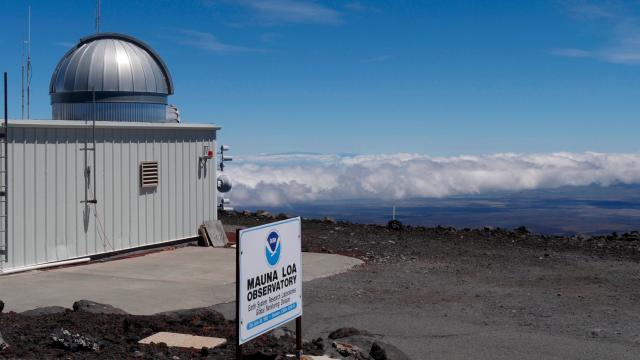The world ground to a halt for parts of last year, but carbon dioxide continues to set records. Concentrations in the atmosphere of the greenhouse gas peaked last month, scientists said Monday, reaching a new historic monthly average high of 419 parts per million. That’s the highest average level in millions of years. Awesome!
The new average comes from readings from the Mauna Loa Atmospheric Baseline Observatory, a research station operated by the National Atmospheric and Oceanic Administration and the Scripps Institution of Oceanography, where scientists have been recording carbon dioxide concentrations since 1958, when carbon dioxide was at 316 ppm. And those recordings have taken a sharp turn upwards recently. We first passed the 400 ppm mark in 2013, so the rate at which we’ve already gotten to 419 ppm is pretty alarming. Carbon dioxide levels have exceeded daily readings of 420 ppm twice this year. (Yearly averages tend to peak in May; plants absorb a lot of carbon dioxide during the summer growing season, while plants and soil start releasing carbon dioxide in the fall and winter.)
“We are adding roughly 40 billion metric tons of carbon dioxide pollution to the atmosphere per year,” Pieter Tans, a senior scientist with NOAA’s Global Monitoring Laboratory, said in a release. “That is a mountain of carbon that we dig up out of the Earth, burn, and release into the atmosphere as carbon dioxide — year after year. If we want to avoid catastrophic climate change, the highest priority must be to reduce carbon dioxide pollution to zero at the earliest possible date.”
While record-keeping at the observatory spans 63 years, fossils, ice cores, and other geologic records help scientists determine what Earth’s atmosphere was like before we started directly collecting data. Atmospheric carbon dioxide is now on par with where it was in the Pliocene Epoch, around 4 million years ago, when world temperatures were around 14.4 degrees Fahrenheit (8 degrees Celsius) warmer than they are now, the Arctic was ice-free in the summer and probably full of green trees and plants, and wooly mammoths, saber-toothed tigers, giant sloths, and armadillos were wandering around.
Scientists recorded a monthly average of 417 ppm of carbon dioxide in May 2020, and the rise year-over-year is a bit smaller than previous years. What’s really concerning is that even though much of the world was on pause due to the pandemic, carbon dioxide emissions seem to be right back on track. Scientists said that the increase in carbon dioxide over the first 5 months of 2021 was at 2.3 parts per million, which is around the average annual increase between 2010 and 2019. That increase was despite the fact that global energy use decreased by 4% and emissions fell 5.8%, the International Energy Agency said in a recent report. That’s the biggest-ever decline in emissions on record in 2020 and roughly “the equivalent of removing all of the European Union’s emissions from the global total,” the IEA said. Findings early in the pandemic also tracked the dip in carbon dioxide, but now it appears we’re heading in the wrong direction despite recent climate pledges by President Joe Biden and other world leaders to get emissions under control.
“As long as we keep emitting, carbon dioxide will keep going up,” Tans told Axios. “And that’s what we see. Even if we manage to freeze net emissions.”
